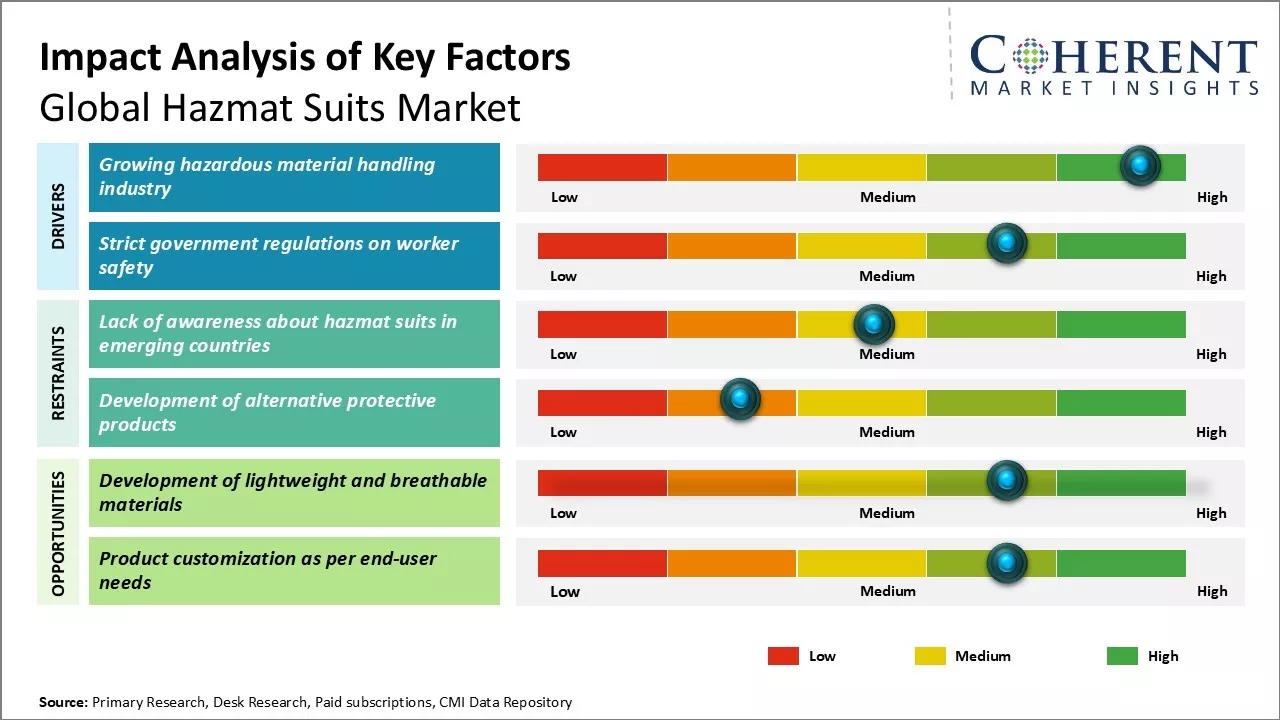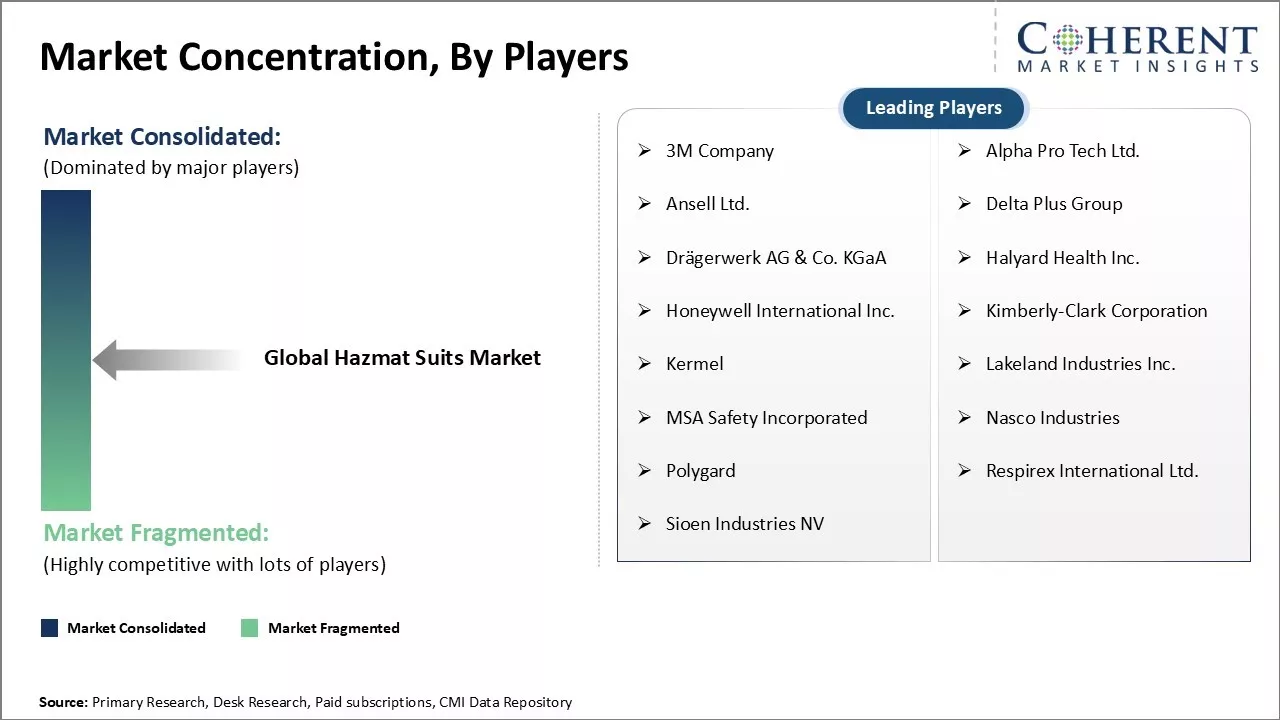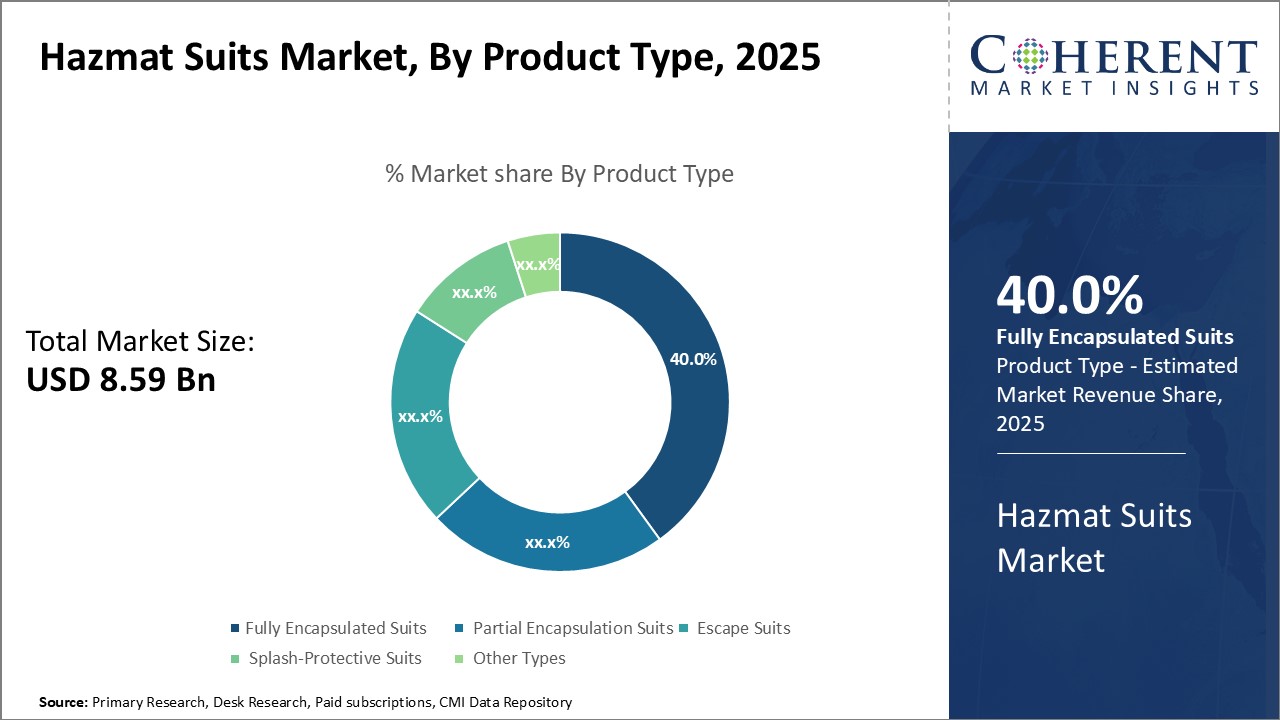Hazmat Suits Market Size and Trends
Global hazmat suits market is estimated to be valued at US$ 8.59 Bn in 2025 and is expected to reach US$ 13.98 Bn by 2032, exhibiting a compound annual growth rate (CAGR) of 7% from 2025 to 2032.

Discover market dynamics shaping the industry: Download Free Sample
Increasing awareness regarding safety at workplaces across various industries and rising number of hazards and risks boosts demand for protective clothing including hazmat suits. Growing petrochemical and pharmaceutical industries worldwide also boosts the need to protect workers from harmful and toxic materials, thus, driving the hazmat suits market growth. Major players in the hazmat suits market are investing in research & development to develop advanced fabric for suits that provide higher protection along with proper movement and comfort. Introduction of technologically advanced products equipped with features like communication devices, biomonitoring, and head protection can drive the hazmat suits market growth in the near future.
Market Driver - Growing hazardous material handling industry
The hazardous material handling industry has been witnessing growth over the past few years due to increasing industrial and commercial activities. A wide range of industries such as chemical and petrochemical, pharmaceutical, oil and gas, mining, nuclear, and others routinely deal with toxic, reactive, flammable and hazardous substances. With expanding operations of these industries worldwide, there has been increase in requirements for specialized protective equipment and gears for workers handling hazardous materials.
Hazmat suits have become an integral part of daily operations and safety protocols for numerous companies involved in production, transportation, storage and usage of dangerous chemicals and substances. These full body protective suits are designed to create a reliable barrier between the user and surrounding hazardous environs, and are made using multiple layers of specially engineered materials like Tyvek, laminated polyamide, and GORE-TEX. These provide 360-degree protection from chemicals, vapors, mists and particles through their seam-sealed design and completely cover the wearer's body, head, hands and feet.
Especially in emerging markets, there has been huge investment in industries that involve handling of hazardous materials. For example, the construction of new oil refineries, petrochemical plants and chemical manufacturing hubs has accelerated in countries across Asia Pacific and Middle East regions. This boosts demand for personal protective equipment (PPE) including hazmat suits from such markets. Mining operations are scaling up significantly in major economies like China, Brazil and Australia, and this has boosted the requirement of protective clothing for workers dealing with toxic mining chemicals and waste materials.
With growing complexity of industrial operations, there has been increase in hazards posed by chemicals. Accidents and exposure to hazardous materials continue occurring at workplaces despite safety protocols. This has made compliance to protective gear regulations more stringent to prevent any such untoward incidents. Companies are procuring advanced hazmat suits offering maximum protection rather than compromising on worker safety. Therefore, expansion of industries routinely using hazardous materials along with greater investments in worker protection can drive the growth of the global hazmat suits market in the near future.
Market Concentration and Competitive Landscape

Get actionable strategies to beat competition: Download Free Sample
Strict government regulations on worker safety
Worker safety acts as a top priority for government agencies globally and there has been constant emphasis on establishing stringent regulatory standards to protect employees from occupational hazards. Regulatory bodies extensively monitor compliance of organizations employing workers that handle toxic and dangerous chemicals on regular basis. Environmental, health and safety rules relating to the use of personal protective equipment (PPE) are being tightened further with time to prevent any work-related illnesses or injuries.
Requirements around selection and utilization of hazmat suits tailored as per the nature of risks are becoming more defined and comprehensive under revisions to existing regulations. Specific guidelines exist for suit material, seam sealing, wrist and neck construction based on the classes and levels of hazards involved with the tasks. Significant penalties and fines act as a deterrent for non-compliance and have made businesses extra cautious regarding procurement of certified protective clothing. Industry associations also play an active role in promoting adoption of best safety practices and latest protective gear to foster a threat-free work environment.
With growing precedence of legal cases pertaining to occupational health issues, there has been increase in onus on organizations to demonstrate compliance and due diligence. There has been rising awareness among employees about their rights and legal recourse available in case of work-related illness or accident. Regulators are auditing companies more frequently and methodically with a zero-tolerance policy towards laxity in following mandated safety standards. This has compelled industries involved in hazardous operations to invest in high-quality protective solutions like hazmat suits from reputed brands in order to avoid any violation or problems from inspection authorities.
Regular changes to safety norms also necessitate replacement of existing protective gears as and when the assigned protection level gets outdated due to revised certification criteria.
Key Takeaways from Analyst:
North America dominates the market due to stringent worker safety regulations and a large number of industrial applications that require hazmat protection. However, Asia Pacific is poised to emerge as the fastest growing regional market due to rapid industrialization and infrastructure development in major economies like China and India that boosts need for hazardous materials protection gear. Growing nuclear and chemical industries can drive the hazmat suits market growth. Increasing threat of biological and chemical attacks as well as greater focus on industrial safety can boost demand. Furthermore, rising environmental regulations governing the handling of toxic and radioactive waste can drive the market growth. High costs associated with hazmat suits and lack of awareness in developing nations can hamper its adoption rates.
Penetrating emerging economies and raising safety awareness through training and educational programs can offer opportunities for hazmat suits providers. Ongoing technological advancements make suits lighter, more comfortable and highly protective without compromising on mobility. Development of complementary safety equipment and protocols can offer growth opportunities.
Market Challenge - Lack of awareness about hazmat suits in emerging countries
Global hazmat suits market growth can be hampered due to lack of awareness about hazmat suits in emerging countries. Hazmat suits are essential personal protective equipment used in highly hazardous industrial environments like oil and gas, chemical, mining, and others. However, in many developing nations, the importance of workplace safety is still not recognized fully. There has been lack of stringent regulatory policies mandating the use of PPE like hazmat suits. Working populations in industries handling hazardous materials remain unaware of the health risks. Due to the lack of safety culture and regulations, hazmat suits have limited adoption. This poses serious risks to workers. Market players must focus on creating awareness through educational campaigns, sponsorship of safety forums, and lobbying with policymakers to introduce mandatory rules around hazmat suit usage. Overcoming the awareness gap through collaborative efforts of industries, NGOs, and governments is crucial for the hazmat suits market to tap into the growth potential in emerging economies.
Opportunity: Development of lightweight and breathable materials
Development of lightweight and breathable materials can offer opportunities for the hazmat suits market growth. Currently, hazmat suits are made of materials like rubber, plastic or rubberized fabrics that can be bulky and uncomfortable to wear for longer durations. This acts as a deterrent for wider acceptance and compliance. Technology advancement in textile engineering and material science can help revolutionize hazmat suit designs. The industry is investigating novel lightweight, high-performance fabrics, offering better breathability and ventilation. With R&D investments, smart textiles equipped with features like moisture-wicking, thermoregulation can be developed. This will enhance wearer comfort and allow easier movement. Lightweight hazmat suits will attract more end-use industries and compliance even in warm conditions. Material innovators partnering with hazmat players can capitalize on this opportunity to introduce upgraded product lines.

Discover high revenue pocket segments and roadmap to it: Download Free Sample
By product type, fully encapsulated suits segment is expected to contribute the highest market share of 40.0%, owing to the utmost protection these provide against hazardous materials and work environments.
Fully encapsulated hazmat suits completely seal the wearer from head to toe, shielding them from airborne and liquid threats. These incorporate features like fully sealed zippers, tear-resistant fabrics, and self-contained breathing apparatuses to isolate the user. Industries and tasks with exposure to highly toxic substances, such as nuclear power and waste management, depend on fully encapsulated suits to keep personnel safe in even the most hazardous conditions. Their comprehensive coverage makes them ideal for responding to emergencies and potential contaminant leaks where absolute protection is paramount.
By material, polymer-based suits segment is expected to contribute the highest market share of 51.7%, due to their versatile functionality and durability. Fabricated from robust yet lightweight synthetic polymers, these suits withstand exposure to a wide range of dangerous chemicals while retaining flexibility. Polymer materials like PVC and polyurethane create barriers impermeable to liquids and resistant to degradation over repeated use. These also feature noise and puncture protecting layers for jobs requiring manual labor. Advanced polymers have allowed suit designers to enhance features like thermal insulation, abrasion resistance, and moisture wicking, thus, expanding the types of hazardous tasks polymer suits can support. Their hardy composition makes them well-suited for sustained use in industrial production and waste facilities.
By end-use industry, hazardous materials handling and disposal segment is expected to contribute the highest market share of 44.3%, owing to stringent safety compliance and specialized operations. The waste management industry handles an immense variety of potentially toxic substances across diverse facilities from landfills to incinerators. Strict regulations necessitate comprehensive personal protective equipment, especially for roles with direct exposure like transportation, sorting, and equipment operation. Unforeseen conditions like spills and equipment malfunctions require rapid isolation capabilities. Hazmat suits specially tailored for waste handling protect workers from nuisances like odors as well as health and safety risks. Their impermeability and durability suit the demanding conditions of waste processing facilities to keep personnel and the environment protected throughout waste disposal processes.
Regional Insights

Need a Different Region or Segment? Download Free Sample
North America dominates the global hazmat suits market with 34.6% share in 2025, owing to stringent worker safety regulations in key countries like the U.S. Large biochemical and pharmaceutical companies in the U.S. and Canada have boosted demand as these require their employees and workers to wear protective suits while handling hazardous materials. Presence of top players in North America who are continuously innovating and expanding their offerings has boosted the market growth.
Asia Pacific region has emerged as the fastest growing market for hazmat suits. Rapid industrialization and growth of manufacturing sector in major economies like China and India has boosted the need for protective equipment. Due to growing concerns over safety of workers handling chemicals and other toxic substances, there has been increase in sales of hazmat suits. Ease of doing business and availability of affordable labor in Asia Pacific makes it an attractive manufacturing destination for industries like chemicals, oil & gas, mining, and others. This has positively impacted the adoption of hazmat suits.
Some other factors contributing to market growth in Asia Pacific include growing export focus of regional manufacturers towards developed nations and increasing domestic consumption. While North America still has larger installed base of end-use industries, Asia Pacific is fast catching up given its immense growth opportunities. Regional governments are also promoting worker safety which has raised awareness about use of protective gears. This has provided the necessary impetus for the hazmat suits market to expand rapidly in Asia Pacific. Both North America and Asia Pacific regions are prominent in terms of demand as well as production capabilities for hazmat suits globally.
Market Report Scope
Hazmat Suits Market Report Coverage
| Report Coverage | Details | ||
|---|---|---|---|
| Base Year: | 2024 | Market Size in 2025: | USD 8.59 Bn |
| Historical Data for: | 2020 To 2024 | Forecast Period: | 2025 To 2032 |
| Forecast Period 2025 to 2032 CAGR: | 7.2% | 2032 Value Projection: | USD 13.98 Bn |
| Geographies covered: |
|
||
| Segments covered: |
|
||
| Companies covered: |
3M Company, Alpha Pro Tech Ltd., Ansell Ltd., Delta Plus Group, Drägerwerk AG & Co. KGaA, Halyard Health Inc., Honeywell International Inc., Kimberly-Clark Corporation, Kermel, Lakeland Industries Inc., MSA Safety Incorporated, Nasco Industries, Polygard, Respirex International Ltd., and Sioen Industries NV |
||
| Growth Drivers: |
|
||
| Restraints & Challenges: |
|
||
Uncover macros and micros vetted on 75+ parameters: Get instant access to report
Hazmat Suits Industry News
- In November 2023, Ansell, a global leader in protective solutions, announced the launch of its new AlphaTec 58-700 Hazmat Suit. This lightweight and breathable suit provides protection against a wide range of hazardous materials, offering workers the necessary protection, comfort, and confidence to handle various risks in industrial environments.
- In July 2022, MBO Group, a China-based manufacturer specializing in refrigeration equipment and air conditioning solutions, developed a wearable air-conditioning system that is designed specifically for COVID-19 workers in hazmat suits. As daily testing became routine for millions, this innovative device weighs 3 kilograms and features an air conditioning system along with a cooling vest. It offers a temperature adjustment range of 16 to 25 degrees Celsius and can operate for up to three hours on a full charge.
- In May 2022, Kappler, Inc., a leading manufacturer of protective clothing based in Alabama, U.S., partnered with Lakeland Industries, a U.S.-based prominent provider of industrial protective apparel, to enhance chemical worker protection in India. This partnership allows Indian industry workers to access Kappler's innovative hazmat products, including Zytron, Frontlne, and DuraChem, thereby improving safety standards for those handling hazardous materials.
*Definition Global hazmat suits market involves protective suits used for emergency response, chemical spills, and hazardous material handling. Hazmat suits provide complete protection against chemical, biological, radiological, and nuclear threats. These are designed to prevent hazardous materials from making contact with the skin or being inhaled/ingested. Global hazmat suits market includes different types of suits based on protection levels and applications like Level A, Level B, Level C, and Level D suits.
Market Segmentation
- Product Type Insights (Revenue, US$ Bn, 2020 - 2032)
-
- Fully Encapsulated Suits
- Partial Encapsulation Suits
- Escape Suits
- Splash-Protective Suits
- Other Types (e.g. Coveralls, Aprons)
- Material Insights (Revenue, US$ Bn, 2020 - 2032)
-
- Polymer-Based Suits
- Coated Fabrics
- Rubber-Based Suits
- Other Materials (e.g. Neoprene, Polyethylene)
- End-use Industry Insights (Revenue, US$ Bn, 2020 - 2032)
-
- Hazardous Materials Handling and Disposal
- Oil and Gas
- Chemical Industry
- Pharmaceutical and Biomedical
- Emergency Services (Fire, Rescue, EMS)
- Other Industries (e.g. Mining, Agriculture)
- Regional Insights (Revenue, US$ Bn, 2020 - 2032)
- North America
- U.S.
- Canada
- Latin America
- Brazil
- Argentina
- Mexico
- Rest of Latin America
- Europe
- Germany
- U.K.
- Spain
- France
- Italy
- Russia
- Rest of Europe
- Asia Pacific
- China
- India
- Japan
- Australia
- South Korea
- ASEAN
- Rest of Asia Pacific
- Middle East
- GCC Countries
- Israel
- Rest of Middle East
- Africa
- South Africa
- North Africa
- Central Africa
- North America
- Key Players Insights
- 3M Company
- Alpha Pro Tech Ltd.
- Ansell Ltd.
- Delta Plus Group
- Drägerwerk AG & Co. KGaA
- Halyard Health Inc.
- Honeywell International Inc.
- Kimberly-Clark Corporation
- Kermel
- Lakeland Industries Inc.
- MSA Safety Incorporated
- Nasco Industries
- Polygard
- Respirex International Ltd.
- Sioen Industries NV
Share
Share
About Author
Suraj Bhanudas Jagtap is a seasoned Senior Management Consultant with over 7 years of experience. He has served Fortune 500 companies and startups, helping clients with cross broader expansion and market entry access strategies. He has played significant role in offering strategic viewpoints and actionable insights for various client’s projects including demand analysis, and competitive analysis, identifying right channel partner among others.
Missing comfort of reading report in your local language? Find your preferred language :
Transform your Strategy with Exclusive Trending Reports :
Frequently Asked Questions
EXISTING CLIENTELE
Joining thousands of companies around the world committed to making the Excellent Business Solutions.
View All Our Clients
